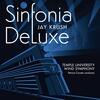Sinfonia DeLuxe (Symphony #3) by Jay Krush
I. Prairies and Skyscrapers
II. Ghost Songs
III. Streamliner
The genesis of “Sinfonia DeLuxe,” my Symphony #3, started with an observation by the Dutch composer Louis Andriessen, that the only completely new large ensemble to achieve currency and longevity in the 20th Century was the big band. He went on to comment that, unlike the orchestra, which is dominated by instruments made of wood, the big band reflects its time as a dramatic musical machine made predominantly of gleaming metal.
These comments struck a number of sparks: First, the realization that the modern Wind Ensemble loosely resembles an 18th Century “harmonie” ensemble (oboes, clarinets, bassoons, horns, sometimes flutes), grafted onto a big band (trumpets, saxophones, trombones and rhythm section). That the instruments of one are made primarily of organic materials (even the sole metal instruments, the horns, had a long history of outdoor and forest use), and the other is mostly metallic, suggested a pastoral versus urban dynamic. The connection with big bands also brought up both the feel of Art Deco/Style Moderne design, and similarities between the 1930s and the present day.
Sinfonia DeLuxe references older popular, vernacular and “roots” music, which has been around long enough to have symbolic, political and social connotations to most Americans. This music is not referenced to be nostalgic, or “retro,” but to explore how the past informs, and lives on, in the present.
In the first movement, “Prairies and Skyscrapers,” (whose title was inspired by an essay on American music by the musicologist, Wilfrid Mellers), the “pastoral” and “urban” ensembles have completely different musical materials from each other, reflecting the urban/rural divides that have often occurred in US history. While they coexist on the same stage, the two groups share materials only very briefly in a moment that is less a synthesis than a collision. The movement ends with a coda that conveys hope for peaceful coexistence.
Much of our popular music has its roots in poverty, displacement and marginalization. The second movement, “Ghost Songs,” was influenced by the field recordings of musicologists such as Alan Lomax, in which we can still hear the voices the dead, singing despite the burdens of their lives. The music travels through the sounds of a melancholy, Appalachian-style ballad, a prison call-and-response work song (complete with the sound of picks and shovels, the crack of an overseer’s whip, and chains dropped to the floor to resemble the sound of shackles and manacles), a New Orleans funeral march, and a nocturnal big band section inspired by the photographs that the bassist/photographer Milt Hinton took while on tour in the Jim Crow Era South.
There is a direct segue into the final movement, “Streamliner,” a tribute to a design era when even toasters looked like they were going fast! The sound image is of a beautiful streamlined train hurtling through the night, across varied landscapes, prairies, towns and cities. A dark, somnolent section with pulsing timpani emerges into a brilliant sunrise and a driving coda which celebrates tremendous energy merged with beauty, grace, and the power to transcend boundaries and bring people together.
“Sinfonia DeLuxe” (Symphony #3) was composed between the summer of 2019 and February, 2020, for the Temple University Wind Symphony. It was premiered by that ensemble, conducted by Dr. Patricia Cornett, in February 2020, at the Temple Performing Arts Center.
-Notes by composer Jay Krush

